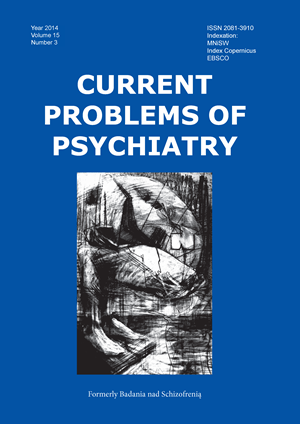Quality of marital relationships in patients with diagnosis of psychotic disorders in both partners – case report
Keywords:
schizophrenia, schizoaffective disorders, quality of marriage relationshipAbstract
This article is about the quality of partner relationships in marriages in which both partners have been diagnosed with psychotic disorders such as paranoid schizophrenia (F 20.0) or schizoaffective disorders of the depressive type (F 25.1). Although within the literature there are relatively precisely descriptions of interpersonal relations in couples with a mental disorder diagnosed in one of the partners [1,2,3,4], much less is known about couples diagnosed with profound psychopathological phenomena in both partners. It seems to be extremely important to analyze the functioning of this patient group with regard to their own perception of their intimate relationship. Moreover, it is as important to understand the effect of both specific and nonspecific psychopathological symptoms as these directly project upon the quality and durability of the partner relationship. The case described here is an attempt to fill in the gaps in terms of the aforementioned notions, and bring into the light, the closer interpersonal dimensions of persons with psychotic diagnoses, taking into account as well, clinical implications important for the further course of their illness.
References
1. Beach S. R. H., Winters K. C., Weintraub S. Marital Dissolution and Distress in a Psychiatric Population: A Longitudinal Design, Behavioral Residential Treatment, 1998; 1(4): 217-229.
2. Mizuno E., Iwasaki M., Sakai I. Subjective Experiences of Husbands of Spouses With Schizophrenia: An Analysis of the Husbands' Descriptions of Their Experiences, Archives of Psychiatric Nursing, 2011; 25(5): 366–375.
3. Seeman M. V. When and How Should I Tell? Personal Disclosure of a Schizophrenia Diagnosis in the Context of Intimate Relationships, Psychiatric Quarterly, 2013; 84: 93–102
4. Crowe M. Couples and mental illness, Sexual and Relationship Therapy, 2004; 19(3): 309-318.
5. Chuchra M. M. Czas trwania psychozy a poczucie zmiany siebie chorych na schizofrenię paranoidalną, Roczniki psychologiczne, 1999; II: 185-205.
6. Wciórka J. Psychozy schizofreniczne. W: Bilikiewicz A. red., Psychiatria. Podręcznik dla studentów medycyny. wyd.3., Warszawa; Wydawnictwo Lekarskie PZWL: 270-309.
7. Seligman M. E. P., Walker E. F., Rosenhan D. L. Psychopatologia. Poznań; Wydawnictwo Zysk i S-ka: 2003.
8. Beck A T., Rector N. A., Stolar N., Grant P. Schizofrenia w ujęciu poznawczym. Teoria, badania i terapia. Kraków; Wydawnictwo Uniwersytetu Jagiellońskiego: 2010.
9. Wciórka J., Pużyński S. Klasyfikacja zaburzeń psychicznych i zaburzeń zachowania w ICD-10. Badawcze kryteria diagnostyczne. Kraków – Warszawa; Uniwersyteckie Wydawnictwo Medyczne „Vesalius” Instytut Psychiatrii i Neurologii: 1998.
10. Wciórka J. Kryteria diagnostyczne według DSM-IV-TR. Wrocław; Elsevier Urban & Partner: 2008.
11. Morrison J. Diagnoza psychiatryczna. Praktyczny podręcznik dla klinicystów. Kraków; Wydawnictwo Uniwersytetu Jagiellońskiego: 2012.
12. Manley M. Psychiatria. Praktyczny przewodnik kliniczny. Wrocław; Elsevier Urban & Partner: 2010.
13. Gabbard G. O. Psychiatria psychodynamiczna w praktyce klinicznej. Kraków; Wydawnictwo Uniwersytetu Jagiellońskiego: 2009.
14. Wiener D., Andrzejewska M., Bodnar A., Rybakowski J. Zaburzenia teorii umysłu oraz empatii w schizofrenii i chorobie afektywnej dwubiegunowej, Neuropsychiatria i Neuropsychologia, 2011; 6(2): 85–92.
15. Schanks J., Atkins P. Psychiatric patients who marry each other, Psychological Medicine, 1985; 15(02): 377-382.
16. Myung-Yee Y., Woochan S. Couples with Schizophrenia ‘‘Becoming like Others’’ in South Korea: Marriage as Part of a Recovery Process, Family Process, 2009; 48: 429–440.
17. Ryś, M. Jakość i trwałość małżeństwa: propozycja skali. Problemy Rodziny, 1994; XXXIV (3): 19-20.
D. Żmuda, M. Orzeł – Górniak, A. Urbańska, M. Makara – Studzińska, M. Olajossy
18. Martowska K. Lista Przymiotnikowa ACL autorstwa Gough H.G., Heilbrun A. B. Jr Warszawa; Pracownia Testów Psychologicznych Polskiego Towarzystwa Psychologicznego: 2011.
19. Plopa M. Więzi w małżeństwie i rodzinie. Metody badań. Kraków; Oficyna Wydawnicza „Impuls”: 2008.
20. Perzyński J. Zawarcie związku małżeńskiego a dalszy przebieg schizofrenii, Postępy Psychiatrii i Neurologii, 2005; 14(1/20): 61-62.


